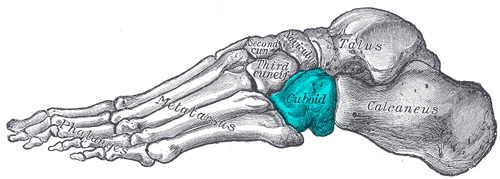
Cuboid Syndrome is a condition in the foot that is often poorly recognised and often underdiagnosed. It is not very common, making up less than 5% of foot injuries. In this condition the cuboid bone is assumed to become partially subluxed due to excessive traction from peroneus longus tendon that passes around the bone. When a foot is overpronated it is assumed that the cuboid is not a stable as a pulley when the peroneus longus muscle contracts. As a result the lateral aspect of the cuboid bone is pulled dorsally and the medial aspect is pulled plantarly. This more of an overuse type injury, however the cuboid may also become subluxed as part of an acute lateral ankle sprain.
Clinically, there is lateral foot pain on weightbearing usually located over the calcaneocuboid joint and cuboid-metatarsal joints. This can present as vague lateral foot pain. Pushing the cuboid bone upwards from below the foot can produce the pain and typically the range of motion is reduced compared to the other side. There have been x-ray finding associated with cuboid syndrome. There are a number of other conditions that can mimic cuboid syndrome such as sinus tarsi syndrome, a stress fracture and peroneal tendonitis. It is also considered a common symptom following plantar fascia surgical release for recalcitrant plantar fasciitis.
The treatment of cuboid syndrome starts off with activity modification, so that activity levels are restricted to what can be tolerated. Ice can be used to help with the initial pain relief. Strapping to immobilize the area is also a good first line approach, typically this is followed foot orthotics to help stabilize the cuboid bone. There is a specific mobilization that is helpful in cuboid syndrome to deal with the subluxation, though there is some controversy around this approach as to exactly what the manipulation is doing.
{openx:878}